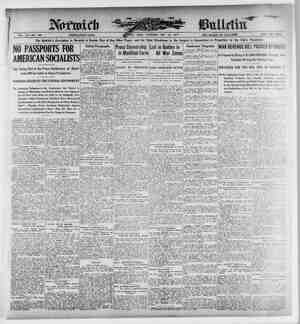The Nonpartisan Leader Newspaper, May 24, 1917, Page 3
You have reached the hourly page view limit. Unlock higher limit to our entire archive!
Subscribers enjoy higher page view limit, downloads, and exclusive features.
2 In the interest of a square deal for the farmers VOL. 4, NO. 21 NONPARTISAN | THANK You,BUT I'M GETTIN' [ GOOD ADVICE AND EXCELLENT RESULTS FROM THESE HERE[JDON'T USE partigan Teader Official Magazine of the National Nonpartisan League — - FARGO, NORTH DAKOTA, THURSDAY, MAY 24, 1917, A magazin: that dares ty print the truth 'ROB THE SoiL! — WORST" DON'T RETAIN The anti-farmer crowd doesn’t believe in ‘‘fertilizer’’ DONT RAISE[|DON'T READ caTTLE! DON'T USE (| PON'T MANORE ! THE LEADER The Worst “Bull”--And More of It An Article by Former President John of North Dakota and Some BY JOHN H. WORST & B \ m URING the month of January 1916 the writer delivered his /el of the TR Tri-State Grain =S¥} Growers’ convention, as usual. Among the matters discussed was losses sustained by farmers, exceeding $55,000,000 annually, under the pre- vailing system of marketing their wheat. The claim was made in that address that if some plan could be adopted that would make North Dakota a manufacturing state, it would enable farmers to export flour instead of raw wheat with an annual saving of ap- proximately $55,000,000. In this the writer was entirely sincere. He had no object in view except to state facts as he understood them. He has no reason for changing his views since then. 2 Several newspapers in different parts “of the state have recently referred to the above figures and by caricatures and insinuations would convey the idea that they are a huge joke; that they are not based on facts and were evi- dently intended "to mislead and to - create prejudice in the minds of farm- ers against the grain gamblers of Minneapolis and Duluth, Such, however, was not the,intention,. - but to indicate possibilities that might be realized by making this a, manu- facturing state instead. of a producer of raw material with farmers depend- ent upon prices fixed for their prod- ucts in a manipulated market. annual address as president .working out of the economic law of ‘‘supply and-demand.”’. .. Injunction to “Note the Big Item” .* * * How It All Came About Tri-State Grain Growers’ convention, in which he showed by figures largely based on the calculations of Dr. E. F. Ladd, then a member of the faculty and now president of the college, that the farmers of North Dakota were losing ON THE BY-PRODUCTS OF WHEAT ALONE, through the system of shipping the wheat out of the state instead of having it economically milled within the state MORE THAN FIFTY MILLIONS OF DOLLARS ANNUALLY. To this he added an estimated loss of roundly five millions of dollars caused by discrimination against the lower grades in the good crop year of 1915 (when there was very little shriveled wheat such as constituted the bulk of the 1916 crop). This made a grand total of FIFTY-FIVE MIL- LIONS OF DOLLARS LOSS DIRECTLY ATTRIBUTABLE TO AN ECONOMICALLY BAD SYSTEM OF MARKETING THE WHEAT CROP OF NORTH DAKOTA IN THAT YEAR. These estimates referred to crop marketing alone, not to any of the other practices of which the farmers in the agricultural states of the Northwest are vietims. And not only, that, but it referred EX. CLUSIVELY TO THE LOSS ON THE WHEAT CROP through this bad system of marketing, built up and dominated by the grain gamb- lers of Minneapolis and Chicago and defended by them as the natural YEAR ago last January Dr. Worst, then president of the Agricultural College of North Dakota, gave an address to the J . i A MARTYR TO THE TRUTH - dle Dr. Worst’s object in this address—then as it is now and has heen during his lifetime of service—was to protect the interests of farming : 3 (Continued on page 4) g “From the present temper of congress there is litt will swing so far toward regulating what hereto make state-owned mills, elevators, etec., look 1 THREE le question but that the federal govemmefit fore has been considered private business as to ike an elementary proposition.”—Dr. Worst. H. Worst of the Agricultural College Comment—With Particular No attempt has been made by the newspapers in question to refute the statements in that address, but by merely making reference to the size of the figures prejudice their readers against their correctness. I am asked, therefore, to restate my reasons for assuming that the state could make a tremendous saving by exporting flour instead of wheat, leav- ing the details of how that result chn be attained for future consideration. The question is one of possibility, and possibilities can always be realized when intervening obstacles are cleared away and conditions are complied with, WHEAT MUST REMAIN THE CHIEF MONEY CROP Making due allowance for a wide diversity of crops, including the culti- vation of a much larger acreage of al- falfa and corn and engaging more generally in the production of beef, dairy products, mutton, wool, etc., the natural .conditions of the state ‘war- rant, and the country at large de- mands, an annual average production of not less than 100,000,000 bushels of wheat in . North Dakota. In other words wheat should and always will be the principal money crop of the state, - . . 5 How to obtain the maximum profits from 100,000,000 bushels of wheat is a fair. proposition. It is worthy of the most serious consideration. Hitherto, and doubtless for years to come, farm- ers will continue to get for their wheat such prices as the chambers of com- —_— e WHOLE NUMBER 88 | i 4






